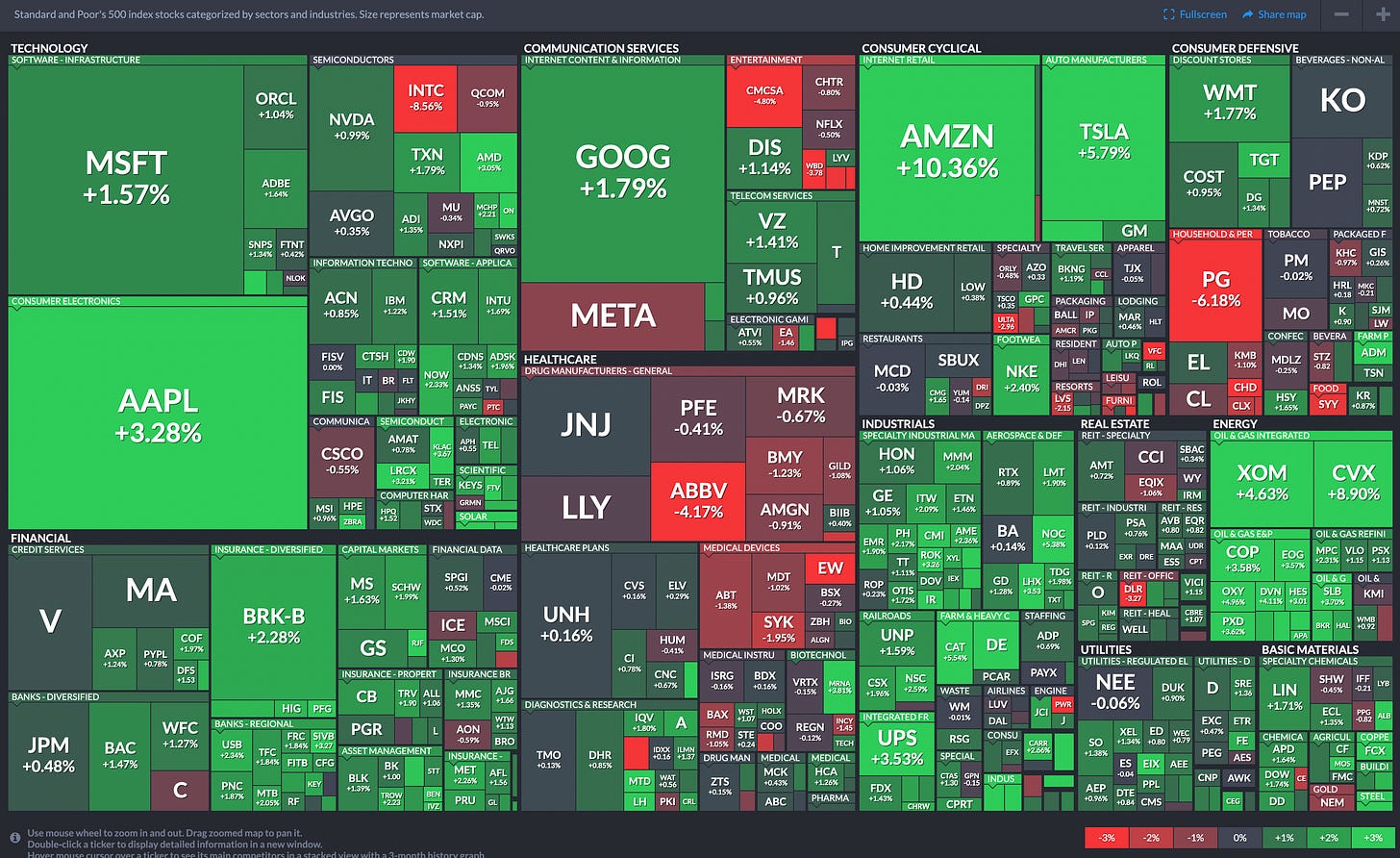(Slightly longer report than usual this time around, but last week was a doozy)
Last week’s big story was always supposed to be the Fed’s interest rate hike on Wednesday but in the end, that proved to be rather uneventful and lacked any kind of a wow moment. The surprise-averse stock market absolutely loved that.
But what really generated a huge amount of heat but precious little light was the often hyperbolic, ill-informed and sometimes blatantly politically motivated media reaction to the preliminary estimate of Q2 2022 Gross Domestic Product (GDP) on Thursday. Who knew that the release of a Q2 GDP initial estimate could generate such passion and vitriol?
The week began with an indecisive, meandering session on Monday, but after the close, retail juggernaut Walmart (WMT) shocked the market. It’s been staring us in the face for weeks, if not months. But it took Walmart to announce it, that higher prices for food and fuel were forcing shoppers to hold back on other items and that its previous outlook and guidance for Q2 and the full year was very wrong and needed to be meaningfully changed (and not in a good way), to really make investors realize: Inflation is now finally starting to cause a real demand problem in the US economy.
Supply shortage has become overstocking. And if the biggest US retailer is feeling it so badly, then who else can possibly escape the pain? Walmart stores have too many unsold items and it is going to have to slash prices to reduce its merchandise inventory levels. The stock crapped out nearly 10% in after-hours trading on Monday before making up some ground later in the week.
The announcement and its implications and aftermath sent a shiver through the whole market when things opened on Tuesday morning. All the giddy, boisterous optimism of the week before was sucked out of the atmosphere as investors apprehensively approached hugely significant earnings from the big guns, the Fed interest rate decision and the initial Q2 GDP print.
A less-hawkish-than-feared, yet still inflation-fighting-focused, Federal Reserve doing what was expected was precisely what markets wanted to see on Wednesday and they got it. The central bank duly raised interest rates by 0.75% for the second time in as many months. The Fed Funds rate now stands at a target range of 2.25% to 2.50%. During his press conference Fed Chairman Jerome Powell emphasized the Fed’s commitment to restoring price stability and said failing isn’t an option. Another 0.75% hike might be necessary at the Fed’s next meeting in late September, he said, but there is a lot of time and a lot of data releases between now and then.
He essentially acknowledged a slowing economy while still emphasizing that inflation was unacceptably high. That combination seemed to thread the needle perfectly as far as the stock market was concerned. The Fed isn't giving up the fight against inflation, but it isn't flagrantly driving the economy into a recession either. Stocks were unable to find any negativity and rallied hard after the decision was announced, pushing even higher during Powell’s presser.
Two back-to-back quarters of negative growth as measured by GDP is often considered as a common rule of thumb that a recession is underway, but actually this is just table stakes for a recession declaration.
The group of eight economists at the National Bureau of Economic Research (NBER) who get to officially call it also evaluates a range of other indicators such as retail sales, personal income and consumption, manufacturing output and, very importantly, the labor market in reaching their conclusion and the process has always been fuzzy. Its official mandate does not even mention GDP or two consecutive quarters; “The determination of the months of peaks and troughs is based on a range of monthly measures of aggregate real economic activity published by the federal statistical agencies”.
As I have mentioned in a previous report, they consider their audience to be future economic historians and statisticians in three, five, twenty or a hundred years’ time looking back on long-ago recessions. They are absolutely not into producing real-time information for use by hedge funds, day-traders, black box algorithm designers, CNBC pundits or opportunistic party political snipers.
It was announced on Thursday that the initial estimate for quarterly GDP for Q2 2022 was -0.9% following the final estimate for Q1 of -1.6%, which inevitably led to many squealing media outlets confidently announcing an official recession based on the “two consecutive quarters” misapprehension.
Let me be clear, even if we do end up with two consecutive quarters of negative GDP prints even after two more revisions for Q2, the US economy was very clearly not contracting in either quarter in 2022, and is right now not (yet) in a recession. How can I say that with such confidence?
First, drawing any conclusions from Thursday’s GDP report is premature and risks making one look foolish. A final quarterly GDP number actually comes in a process of three incremental reports over a period of many weeks which can change dramatically from report to report as more data becomes available. The number on the third report is deemed to be the official figure for that quarter. What came out last Thursday was just the first estimate of the three for Q2 which is based on the least amount of data and will doubtless be heavily revised on two separate occasions in the coming weeks.
Second, the main (some would argue “only”) reason US GDP showed as negative in Q1 was because of inventory builds and imports. Remember, GDP was created to measure the “net output” of the US economy, so anything imported is deemed to subtract from US economic output (GDP was created in a very different global economy). It was the statistical influence of the inventory builds and imports (also spurred by a strong dollar) that pushed Q1 GDP into negative territory.
The fact is that Americans spent money like water in the first half of the year and that the US economy grew solidly in Q1 according to any and all measures of consumer spending (which rose 1.8% in Q1 and followed that up with another 1.0% increase in Q2) and consumption as well as ridiculously buoyant labor market data.
Third, Q2 2022 saw retail sales, durable goods spending, personal consumption, consumer and business spending and investment all move higher again. US corporate earnings handily beat estimates most of the time. Most importantly, the economy has added 2.75 million jobs since New Years’ Day and the unemployment rate has remained steady at a historically low rate of around 3.6% all year.
You cannot be experiencing a recession while the economy is sporting those kind of numbers, no matter what GDP estimates say.
While Thursday’s GDP numbers were no good at all to anyone trying to draw a real-time conclusion about where the economy is at, they were really, really good for lazy headline writers and those looking to whip up hysteria for either investor attention, social media eyeballs or party political point-scoring. And that was what was responsible for so much of the nonsense that we saw and read on Thursday and Friday and into the weekend.
Much of Big Tech announced Q2 earnings and forward guidance during the week and the aggregate outcome was probably a 6.5 out of 10. Alphabet/Google, Amazon, Apple, Meta/Facebook and Microsoft haven't been as unstoppable this year as investors have gotten used to seeing over the past decade but their combined weight of close to 25% of the S&P 500 still means that their results matter for the broader market. Collectively, they brought in a total of $354 billion in revenue in Q2, with Amazon and Apple probably happiest with their results and Meta/Facebook, not so much.
To come full circle, we are not in a recession whatever the economist wonks, CNN or Fox News say, nor have we been in one at any time in 2022. But (big but!) what the Walmart announcement finally brought home to everyone last week is that the current level of inflation is starting to prove so damaging that, for all our sakes, it needs to be dealt with absolutely ruthlessly by the Fed.
If not, the next few months could become an economic shit show. Remember, the current stock market rally that has seen the S&P 500 rise by over 9% and the NASDAQ-100 by over 12.5% in July has been entirely underwritten by an assumption that inflation has peaked. If this is not borne out by the Consumer Price Index (CPI) data to be released on August 10th (mark it in your diary!), then “look out below” is all I can say for stock prices.
OTHER NEWS:
Elon being Elon .. Life just keeps throwing curveballs at poor old Elon Musk. Tesla (TSLA) reported last week that it has received a second subpoena from federal regulators concerning CEO Elon Musk’s 2018 tweet in which he falsely claimed he had secured financing to take the electric carmaker private thereby misleading investors. Later in 2018, the company and Musk settled a lawsuit brought by regulators over the tweet and he accepted a $40 million fine and the requirement that he step down as chairman of Tesla. A federal judge in April this year tossed out Musk’s sudden request to scrap the settlement. He is appealing that ruling.
Musk seems to enjoy a sudden U-turn as shown by the Twitter fiasco which is still ongoing. SpaceX staff are continuing to make it clear to anyone who’ll listen that their founder is “a source of embarrassment and distraction” and presides over a toxic culture at the company which, they say, is infested with rampant sexual harassment.
It emerged recently that Musk added kids #7 and #8 to his roster with the birth of twins late last year by an executive at one of his companies, just four months before #9 came along with his partner Grimes. He is still facing claims that he sexually harassed a flight attendant on his private jet in 2016 and then paid her $250k for her silence in 2018.
Then last week, the Wall Street Journal reported that, about three weeks after the birth of #7 and #8 but about three months before the birth of #9, Musk had a liaison last December with the wife of his former close friend, the Google co-founder Sergey Brin, that prompted Brin to file for divorce in January of this year.
There’s little doubt that Musk’s increasingly erratic behavior and casual relationship with both regulatory and social norms is starting to negatively affect the mindset of those who may be otherwise considering investing in companies with which he has any involvement which can ultimately filter through to their stock prices. Interestingly, last week was the first full week of trading for the exchange traded fund TSLQ which delivers the inverse of the daily performance of Tesla (TSLA) stock and it attracted investor attention.
Global gloom .. The International Monetary Fund (IMF) cut its global growth forecast for 2023 from 3.6% in April to just 2.9% this month, and said the world is “teetering on the edge of a recession”.
Still rising fast, but at a slower rate .. US overall home prices in May were 19.7% higher compared with the same month last year, according to the S&P CoreLogic Case-Shiller National Home Price Index. This marks the second month of slower increases, as the housing market cools due to higher mortgage rates and increasing concerns over inflation. In April, the annual gain was 20.6%.
The Twenty City Composite Index increased 20.5%, down from 21.2% in April. Cities seeing the strongest gains were Tampa, Florida, Miami and Dallas, with annual increases of 36.1%, 34% and 30.8%, respectively. Only four of the twenty cities continued to report higher price increases in the twelve months that ended in May versus the twelve month period that ended in April. In February of this year, all twenty cities in the survey were seeing increasing annual gains.
UNDER THE HOOD:
Following the S&P 500’s best July since 1939, SPX (the S&P 500 index price) 4100 is starting to look like the new SPX 3800. If Friday’s breach of SPX 4100 can be maintained, it is going to start to pull in the significant community of professional and institutional investors who follow the practice of trend analysis (see “FINANCIAL TERM OF THE WEEK”, below) and who have been largely absent from buying stocks in 2022. One thing about trend-following in stocks is that it can be self-fulfilling as these investors have a tendency to pile in once they have identified a trend shift and this, of itself, accelerates that shift.
No doubt, the investing environment has improved (to the extent that the market is now likely short term overbought), and several core indicators have gained significant ground in the past two weeks, including the important net spread between Buying Power and Selling Pressure, which shifted in favor of Buying Power on Friday (more as a result of a large decline in selling than a burst in buying).
Unfortunately, while many readings are undoubtedly heading in the right direction, none are quite yet where they need to be to create a truly inviting investing environment. It is important to keep in mind that some had recorded multi-year negative lows as recently as just two or three weeks ago.
Also it is important to recognize that the three lowest volume New York Stock Exchange trading days of 2022 to-date have occurred in July during this recent market recovery. These days’ volumes were even lower than any pre-holiday trading on the days before market closures on Memorial Day and July 4th this year and are therefore more significant than traditional summer slowdowns. As discussed in last week’s review, abnormally low volume suggests a lack of conviction.
Maybe I am like a tough crowd at a comedy club that takes a lot of convincing but, while certainly acknowledging a meaningful improvement in many of the under the hood market conditions, my view of the overall body of technical data is still somewhat curbing my enthusiasm.
Anglia Advisors clients are welcome to reach out to me to discuss market conditions further.
THIS WEEK’S UPCOMING CALENDAR ..
It's the peak stretch of second-quarter earnings season, with about 150 S&P 500 firms scheduled to report this week including Starbucks, CVS, Uber, Advanced Micro Devices, AirBNB, Caterpillar, Paypal, Alibaba, Block/Square, Moderna, Occidental Petroleum, Devon Energy, EBay, Paramount, Caterpillar, Marriott, ConocoPhillips, Warner Bros, Simon Property Group and Electronic Arts.
The highlight of the week, however, will be the Bureau of Labor Statistics' jobs report for July before the market open on Friday morning. Economists' consensus calls are for growth of 250,000 more jobs and for the unemployment rate to remain at 3.6%.
Other economic data out next week will include July’s Manufacturing Purchasing Managers’ Index (PMI) on Monday, followed by the Services PMI on Wednesday. Both measures of activity are seen as declining from June.
On Thursday, the Bank of England will announce a monetary policy decision. An interest rate hike is considered likely.
====
US INVESTOR SENTIMENT LAST WEEK (outlook for the upcoming 6 months):
↑Bullish: 28% (down from 30% the previous week)
→Neutral: 32% (up from 28% the previous week)
↓Bearish: 40% (down from 42% the previous week)
Net Bull/Bear spread .. ↓Bearish by 12 (Bearish by 12 the previous week)
Long term averages: Bullish: 38% — Neutral: 32% — Bearish: 30% — Net Bull-Bear spread: Bullish by 8
Sentiment survey participants are usually polled on Wednesdays
Source: American Association of Individual Investors (AAII).
LAST WEEK BY THE NUMBERS:
finviz.com
- Last week’s best performing US sector: Energy (two biggest holdings: Exxon-Mobil, Chevron) - up 10.7%
- Last week’s worst performing US sector: Communications Services (two biggest holdings: Meta/Facebook, Alphabet/Google) - up 0.7%
- The NASDAQ-100 and the S&P 500 showed almost identical performance last week
- US Markets had a far better week than International Markets with Emerging Markets once again bringing up the rear
- There was barely any difference in performance last week between Large, Mid and Small Cap
- Growth beat Value
- The proprietary Lowry's measure for US Market Buying Power is currently at 174 and rose by 5 points last week and into a dominant position over that of US Market Selling Pressure which is now at 171 and fell by 14 points over the course of the week
- SPY, the S&P 500 ETF, is now above both its 50-day and 90-day moving averages but still below its long term trend line. The 14-day Relative Strength Index (RSI) reading is 66**. SPY ended the week 13.8% below its all-time high (01/03/2022).
- QQQ, the NASDAQ-100 ETF is now above both its 50-day and 90-day moving averages but still below its long term trend line. The 14-day Relative Strength Index (RSI) reading is 64**. QQQ ended the week 21.9% below its all-time high (11/19/2021).
** RSI readings range from 0-100. Readings below 30 tend to indicate an over-sold condition, possibly primed for a technical rebound and above 70 are often considered over-bought, possibly primed for a technical decline.
- VIX, the accepted measure of anticipated upcoming stock market risk and volatility implied by S&P 500 index option trading (often referred to as the“fear index”) ended lower again for the fourth week in a row at 21.3 and remains below its 50-day and 90-day moving averages and its long term trend line.
ARTICLE OF THE WEEK:
This week .. Investing a lump sum when the market is down brings up a lot of issues including that of possible future regret minimization. There’s no one right answer - well, actually there is. But that may not be the way you want to go.
EXPLAINER: FINANCIAL TERM OF THE WEEK:
A weekly feature using information found on Investopedia (may be edited at times for clarity).
Trend analysis is a technique used in technical analysis that attempts to predict future stock price movements based on recently observed trend data. Trend analysis uses historical data, such as price movements and trade volume, to forecast the long-term direction of market sentiment.
Trend analysis tries to predict a trend, such as a bull market run, and ride that trend until data suggests a trend reversal, such as a bull-to-bear market. Trend analysis is helpful because moving with trends, and not against them, will lead to profit for an investor. It is based on the idea that what has happened in the past gives traders an idea of what will happen in the future. There are three main types of trends: short-, intermediate- and long-term.
A trend is a general direction the market is taking during a specified period of time. Trends can be both upward and downward, relating to bullish and bearish markets, respectively. While there is no specified minimum amount of time required for a direction to be considered a trend, the longer the direction is maintained, the more notable the trend.
Trend analysis is the process of looking at current trends in order to predict future ones and is considered a form of comparative analysis. This can include attempting to determine whether a current market trend, such as gains in a particular market sector, is likely to continue, as well as whether a trend in one market area could result in a trend in another. Though a trend analysis may involve a large amount of data, there is no guarantee that the results will be correct.
In order to begin analyzing applicable data, it is necessary to first determine which market segment will be analyzed. For instance, you could focus on a particular industry, such as the automotive or pharmaceuticals sector, as well as a particular type of investment, such as the bond market.
Once the sector has been selected, it is possible to examine its general performance. This can include how the sector was affected by internal and external forces. For example, changes in a similar industry or the creation of a new governmental regulation would qualify as forces impacting the market. Analysts then take this data and attempt to predict the direction the market will take moving forward.
Critics of trend analysis, and technical trading in general, argue that markets are efficient, and already price in all available information. That means that history does not necessarily need to repeat itself and that the past does not predict the future. Adherents of fundamental analysis, for example, analyze the financial condition of companies using financial statements and economic models to predict future prices. For these types of investors, day-to-day stock movements follow a random walk that cannot be interpreted as patterns or trends.
+1 (646) 713-2225 | SIMON@ANGLIAADVISORS.COM | WWW.ANGLIAADVISORS.COM | FOLLOW US ON INSTAGRAM
This material represents an opinionated assessment of the market environment based on assumptions at a specific point in time and is always subject to change at any time. No warranty of its accuracy is given. It is not intended to act as a forecast of future events, nor does it constitute any kind of a guarantee of any future results, events or outcomes.
The material contained herein is at no time ever intended to constitute tax, legal or medical advice. It is also wholly insufficient to be exclusively relied upon as research or investment advice. The user assumes the entire risk of any actions taken based on the information provided in this or any other Anglia Advisors post or other communication.
Posts may contain links or references to third party websites for the convenience and interest of our readers. While Anglia Advisors may have reason to believe in the quality of the content provided on these sites, the firm has no control over, and is not in any way responsible for, the accuracy of such content nor for the security or privacy protocols the sites may or may not employ. By making use of such links, the user assumes, in its entirety, any kind of risk associated with accessing these sites and making any use of the information provided therein.
Clients of Anglia Advisors may maintain positions in securities and asset classes mentioned in this post.
If you enjoyed this post, why not share it with someone or encourage them to subscribe themselves?















